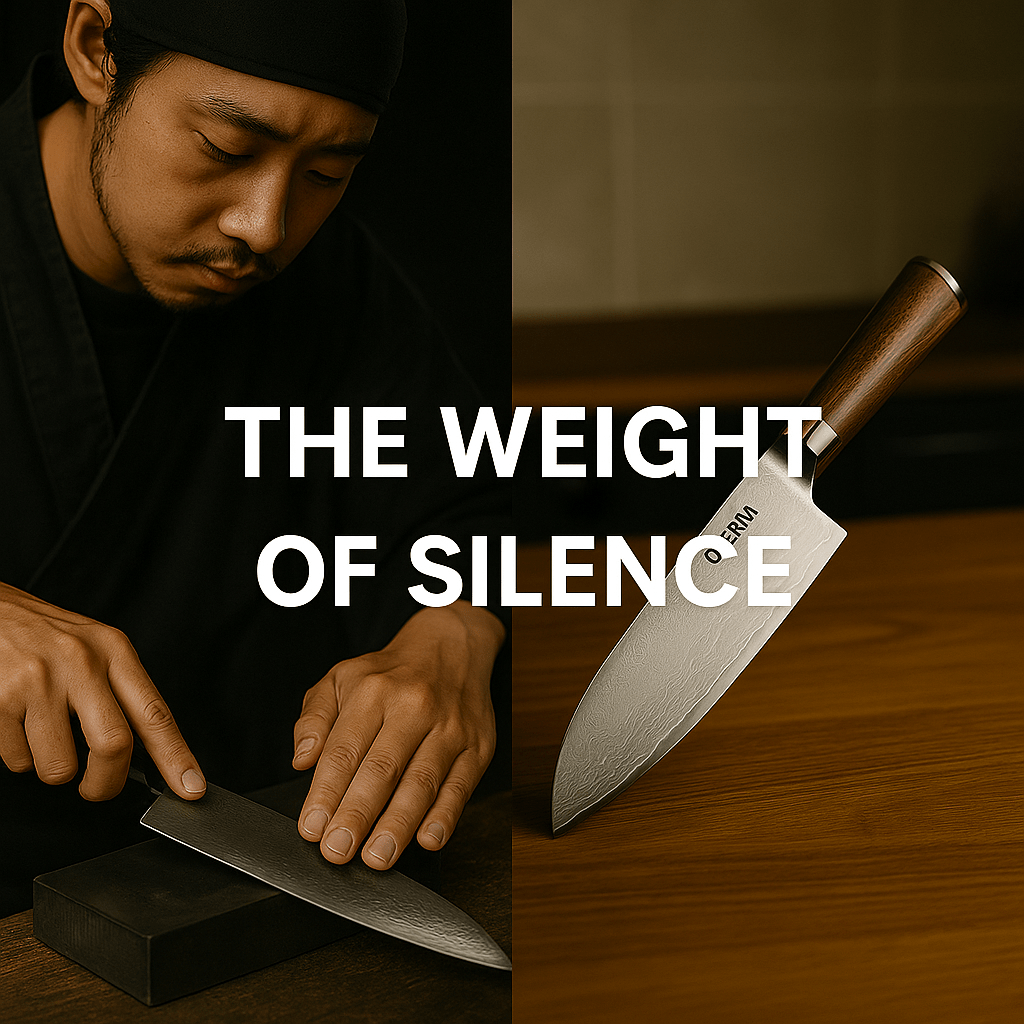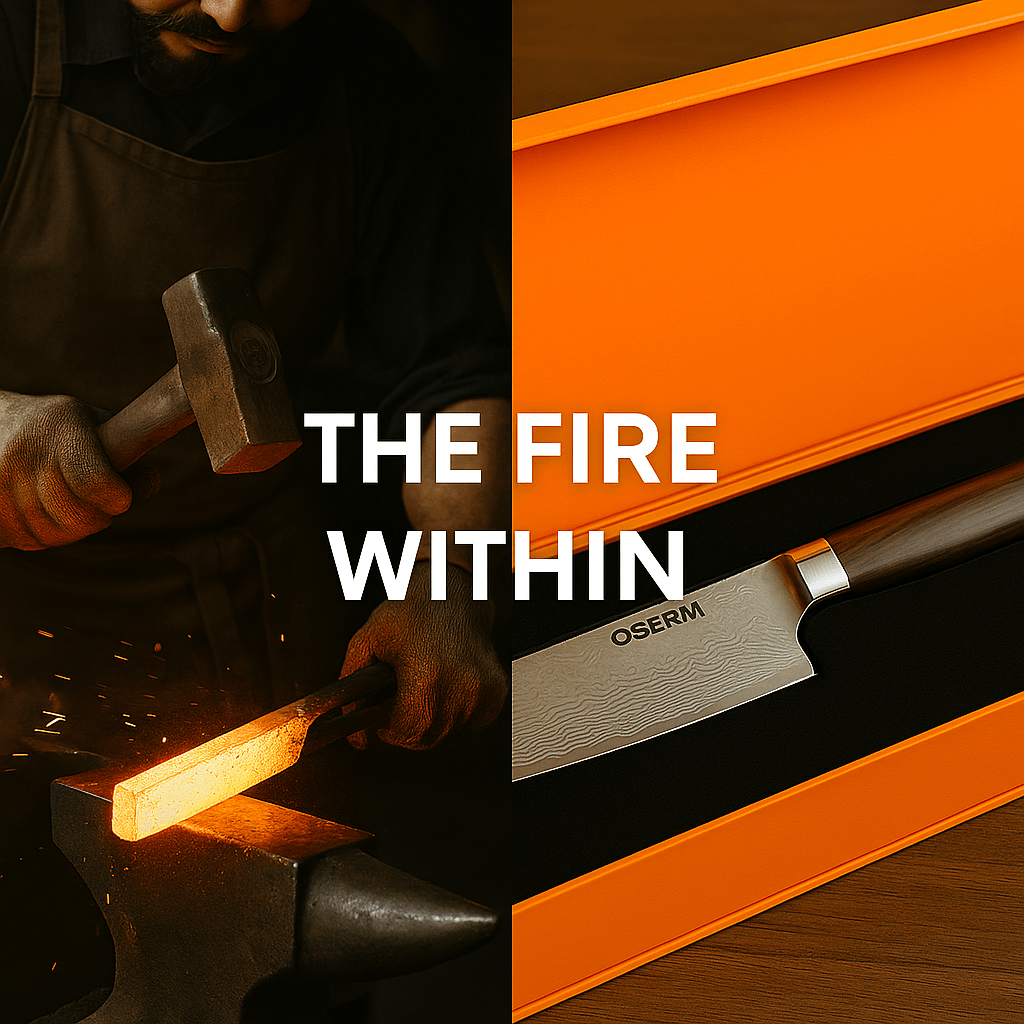
Precision and Poetry – The Dual Nature of a Damascus Knife
Every OSERM knife begins as an idea — the pursuit of balance between two seemingly opposite worlds: precision and poetry. On one side, there’s engineering — the science of metallurgy, geometry, and sharpness. On the other, there’s art — the rhythm of the forge, the curve of the blade, the emotion embedded in craftsmanship. Together, they form a creation that cuts not just ingredients, but through time and meaning itself.
1. The Poetry Hidden in Steel
Steel, in its raw state, is lifeless — rigid, cold, unfeeling. Yet in the hands of a craftsman, it becomes expressive. When folded, hammered, and polished, it starts to breathe. Each OSERM Damascus knife contains 67 layers of folded VG-10 steel, a material born of heat and repetition. But what transforms it into art isn’t just technique — it’s emotion. The shimmering, wave-like Damascus patterns are the handwriting of the maker, each line shaped by his rhythm and patience.
This is where poetry hides: in the unseen hours of labor, in the silent discipline of repetition, in the humility of creation. The final blade doesn’t boast — it whispers. It’s a reminder that perfection doesn’t come from force, but from harmony.
2. The Science of Precision
To the untrained eye, beauty might seem effortless. But beneath every OSERM knife’s elegant surface lies an exacting science. The angle of the blade — typically between 12° and 15° per side — is what gives it its signature sharpness. The VG-10 steel core offers a Rockwell hardness of around 60, balancing durability with flexibility. This isn’t random; it’s mathematics in motion.
Even the handle follows geometric precision. Its weight distribution is calibrated to create a natural flow between grip and motion. This makes the knife feel like an extension of the hand rather than a separate object — a sensation known among chefs as “the invisible connection.”
When poetry meets physics, when the soul of the craftsman meets the logic of the engineer — that’s where true mastery begins. OSERM lives in that intersection.
3. Why Damascus Matters
The Damascus pattern isn’t just decoration — it’s a map of the blade’s journey. Each fold traps micro layers of carbon and steel, strengthening the metal while giving it visual depth. Historically, Damascus steel was legendary for its ability to remain sharp even after heavy use, prized by both warriors and artisans.
Today, OSERM revives this ancient tradition with modern precision. Our craftsmen don’t just recreate the look — they honor the technique. The result is a blade that tells a story of heritage, innovation, and human perseverance. It’s not a knife made for the masses; it’s a knife made for meaning.
4. The Emotional Architecture of a Knife
Designing a knife is an emotional architecture — the creation of an experience as much as a tool. The sound of the blade slicing through vegetables, the weight of the handle in the palm, the quiet satisfaction of effortless performance — these are all parts of the design. A true Damascus knife awakens more than just visual admiration; it stirs a sensory connection between maker, giver, and user.
This emotional design language defines every OSERM knife. From the mirror-polished edge to the subtle transitions between materials, everything exists to balance control and feeling. We call this harmony between touch and function “tactile precision.”
5. From Function to Symbol
In the modern kitchen, a knife isn’t just a utensil — it’s a statement. It represents mastery, taste, and appreciation for craftsmanship. When gifted, it carries even deeper meaning: respect, trust, and a wish for prosperity. The OSERM orange box adds to this narrative — it turns steel into a story, transforming practicality into poetry.
Just as a pen can write words of love or wisdom, a knife can shape moments of care and artistry. Its function is simple, but its impact is emotional. A chef once said, “A good knife doesn’t just cut — it connects.” That sentiment lives within every OSERM blade.
6. The Legacy of Precision
Perfection isn’t an accident. It’s a continuous dialogue between material and maker, vision and technique. OSERM knives are not mass-produced; they are measured, inspected, and refined until they embody that rare balance of sharpness and soul. Each blade carries the quiet confidence of something made to last, not for a season, but for a lifetime.
Precision may create performance — but it’s poetry that makes people remember. Together, they create legacy.
Weekly Deal 🔥
Experience the perfect balance of precision and poetry with OSERM’s Damascus Knife Collection. Forged with 67 layers of VG-10 steel and finished in our signature orange gift box — a masterpiece of art, engineering, and emotion.
Explore OSERM Damascus Collection →
You Might Also Like
- The Weight of Silence – What Makes a True Japanese Knife Different
- The Language of Craft – Why Handmade Knives Speak Beyond Words
- The Art of Gifting Precision – OSERM’s Philosophy of Craftsmanship
Tags: OSERM Damascus knives, VG-10 steel, craftsmanship, precision, poetry, orange gift box, knife making, balance, Japanese design, OSERM philosophy






